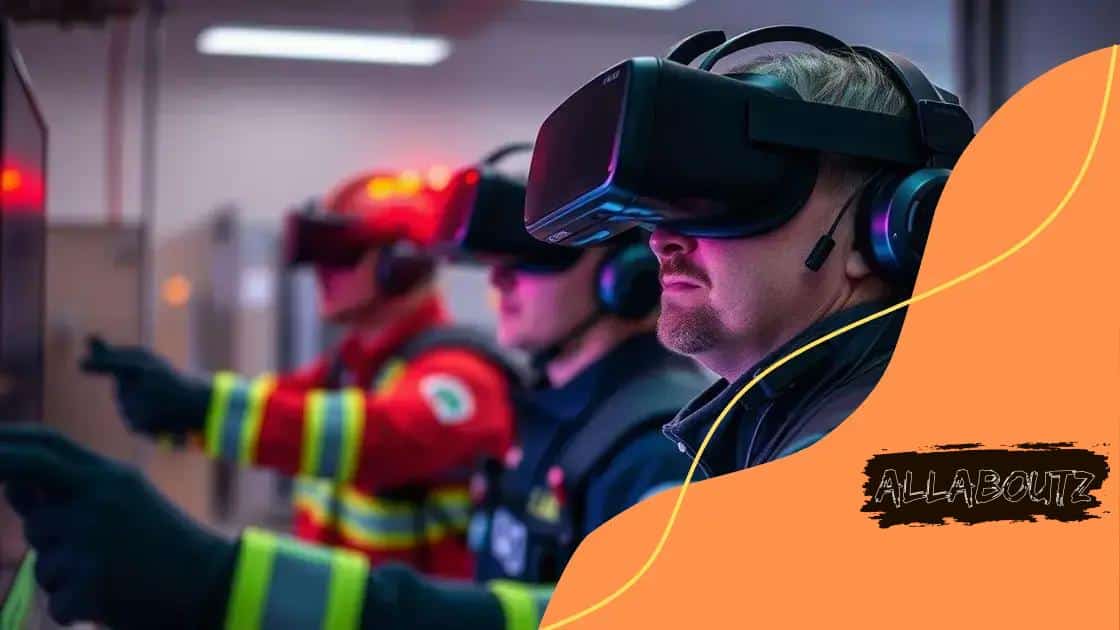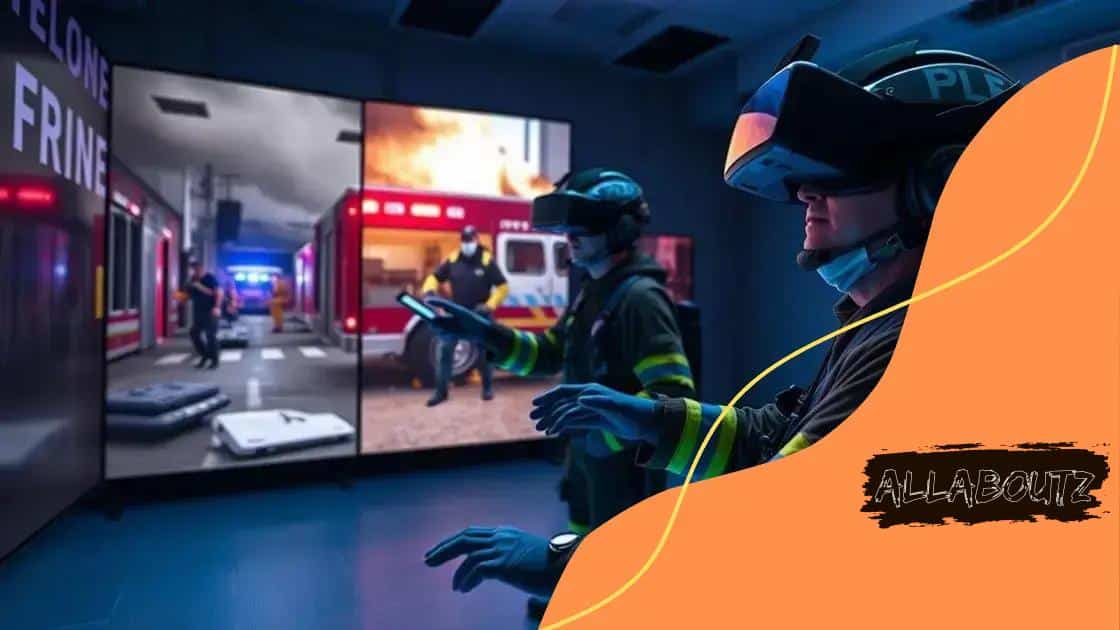Virtual reality in training emergency responders

Virtual reality in training emergency responders enhances preparedness by providing realistic simulations, improving teamwork, and allowing for safe practice without real-world risks.
Virtual reality in training emergency responders is transforming how first responders prepare for crises. Imagine stepping into a lifelike simulation where you can practice your skills without the associated risks. Curious how it shapes training?
Understanding virtual reality technology
Understanding virtual reality technology is crucial for harnessing its full potential, especially in training contexts. It creates immersive experiences that allow users to engage with simulations that mimic reality closely. This technology uses a combination of software and hardware to transport individuals into a digital world where they can practice skills safely.
In essence, virtual reality (VR) involves multiple components. Users wear a headset to block out the real world, experiencing a 360-degree view of the simulated environment. The systems track head and eye movements to create a realistic sense of presence within the virtual space.
Key Components of Virtual Reality
Several elements contribute to the effectiveness of virtual reality technology:
- Hardware: This includes headsets, sensors, and controllers that allow interaction.
- Software: Programs that create the VR environments and scenarios for training.
- Tracking Systems: These systems monitor head movements and gestures to enhance realism.
- Feedback Mechanisms: Haptic feedback devices simulate touch and feel, adding to immersion.
As users interact within these realistic settings, they face scenarios that mimic potential real-life emergencies. This method not only builds skills but also boosts confidence, as they practice decision-making under pressure. Engaging in these simulations helps emergency responders react appropriately when real situations arise.
Furthermore, virtual reality technology allows for repeating challenging scenarios without the associated risks. This aspect is vital for emergency responders, as they can learn from mistakes and refine their techniques. As they undergo extensive training in controlled environments, responders can face more unpredictable challenges.
Benefits of VR for emergency training
The benefits of VR for emergency training are numerous and impactful. This innovative technology offers a safe environment where responders can practice without real-world consequences. Engaging in immersive simulations allows trainees to face realistic scenarios that help build their skills effectively.
One major advantage of VR training is the ability to repeat scenarios until mastery is achieved. Unlike traditional methods, which may limit practice opportunities, virtual reality allows users to experience the same situation multiple times. This repetition is crucial for honing critical decision-making skills in high-pressure environments.
Key Advantages of VR Training
Several key benefits make VR for emergency training an appealing option:
- Realistic Scenarios: Trainees interact in lifelike environments that closely mimic actual emergencies.
- Safe Learning Space: Mistakes can be made and learned from without real-life repercussions.
- Increased Engagement: The immersive nature of VR keeps trainees focused and motivated.
- Immediate Feedback: Users receive real-time information on their performance, aiding improvement.
Additionally, VR for emergency training can enhance team collaboration. Multiple responders can train together in the same virtual environment, improving communication and coordination. This shared training experience leads to better teamwork during real-life emergencies.
Another important benefit is that VR can simulate a variety of situations that emergency responders may encounter. From natural disasters to medical emergencies, trainees are prepared for diverse challenges. They can explore different strategies and responses, ensuring they are equipped to handle any scenario that arises.
Real-world applications of VR in training

Real-world applications of VR in training are growing rapidly across various fields, especially in emergency response. This technology is now being utilized in real-life scenarios to prepare personnel for challenges they may face in the field. By incorporating virtual reality, organizations can enhance their training programs significantly.
In emergency services, VR enables responders to engage in simulations of events like natural disasters, fires, and medical emergencies. Training in these environments prepares them for the chaos and unpredictability of actual situations. By facing stressors in a controlled setting, responders can develop their skills with confidence.
Key Areas of Application
Several key areas highlight the effectiveness of VR in training:
- Disaster Response: Trainees can practice coordinating efforts during events such as earthquakes and floods.
- Medical Emergencies: VR allows for training in trauma care and urgent medical procedures.
- Fire Safety: Responders can experience fire scenarios, enhancing evacuation and firefighting strategies.
- Hazardous Material Handling: Simulations prepare responders for dealing with toxic substances safely.
Moreover, real-world applications extend beyond emergency services. Fields like law enforcement, military training, and even corporate training programs are benefiting from VR technology. Each setting provides unique challenges that can be effectively simulated, allowing participants to learn best practices without exposure to real dangers.
Organizations report that participants in VR training retain information better and feel more prepared for real-life situations. The interactive experience immerses trainees, making learning engaging and effective. As technology advances, the applications of VR in training programs are expected to evolve even further, incorporating more complex scenarios and enhancing learning outcomes.
Challenges in implementing VR training
Implementing VR training comes with several challenges that organizations must address to ensure success. Navigating these obstacles is crucial for maximizing the benefits of virtual reality in training programs. While the advantages of VR are clear, certain barriers can complicate the implementation process.
One of the main challenges is the cost associated with developing and maintaining VR training systems. High-quality hardware and software require significant investment. Organizations must budget not only for initial setup costs but also for ongoing maintenance and updates to keep the training relevant.
Technical Limitations
Another challenge involves the technical limitations of virtual reality technology. Some systems may not be user-friendly, creating a learning curve for instructors and trainees alike. If the technology is too complex, it can hinder effective training sessions. Additionally, hardware issues, such as glitches or compatibility problems, can disrupt the learning experience.
- Hardware Compatibility: Different VR systems may not work seamlessly together.
- Software Bugs: Glitches in training programs can frustrate users.
- User Experience: A complicated interface can lead to confusion during training.
Moreover, the integration of VR training into existing programs can face resistance from staff. Some might be hesitant to adopt new technology due to a lack of understanding or fear of change. Overcoming this resistance requires effective communication about the benefits of the technology and comprehensive training for all users.
Finally, there is the challenge of ensuring that VR content remains up to date and aligned with the latest industry practices. As workflows and technologies evolve, so must training materials. Organizations need a strategy to regularly review and update their VR training content, ensuring that it continues to meet educational goals and industry standards.
Future trends in VR for emergency responders
Future trends in VR for emergency responders promise to enhance training and improve response capabilities even further. As technology continues to advance, the possibilities for virtual reality applications are becoming more exciting and innovative. From more realistic simulations to increased accessibility, these trends will shape the future of training in emergency services.
One significant trend is the integration of artificial intelligence (AI) with virtual reality technology. AI can analyze a user’s performance in training scenarios and provide personalized feedback. This tailored approach helps responders improve their skills at a pace that suits their learning style. Additionally, AI can create dynamic scenarios that adapt in real-time, making each training session unique and challenging.
Enhanced Realism
Another important trend is the development of more immersive environments. Advancements in graphics and haptic feedback technology are making VR simulations increasingly realistic. Emergency responders will be able to train in settings that closely replicate actual crisis situations, helping them build the necessary skills and instincts. As these environments become more lifelike, trainees may also benefit from stress management components integrated into the simulations.
- Improved graphics: Cutting-edge visuals enhance realism and user engagement.
- Real-time feedback: Instant performance analysis to aid skill development.
- Adaptive scenarios: Training situations that evolve based on responder actions.
- Stress management: Tools to help manage stress during training and real emergencies.
Moreover, increasing collaboration through multi-user platforms is becoming a reality. Emergency responders from different departments can train together in the same virtual environment, improving teamwork and communication skills. This collaborative training will prepare them for real-life situations where multiple agencies work together to respond effectively.
Finally, as VR technology becomes more accessible and affordable, organizations will be more likely to adopt it in their training programs. Smaller agencies that previously couldn’t invest in such technology will find new opportunities to implement VR training. This democratization of technology will ensure more responders are prepared, ultimately enhancing public safety outcomes.
FAQ – Frequently Asked Questions about Virtual Reality in Emergency Training
What are the key benefits of using VR for training emergency responders?
The key benefits include enhanced learning in safe environments, realistic simulations, improved teamwork, and personalized feedback through AI.
How does VR help improve team collaboration during training?
VR allows multiple responders to train together in the same virtual environment, which enhances communication and teamwork skills essential in real emergencies.
What challenges might organizations face when implementing VR training?
Organizations may encounter challenges such as high initial costs, technical limitations, user resistance, and the need for consistent content updates.
What future trends can we expect in VR training for emergency responders?
Future trends include enhanced realism from improved graphics, AI integration for adaptive training scenarios, and increased accessibility for smaller organizations.





